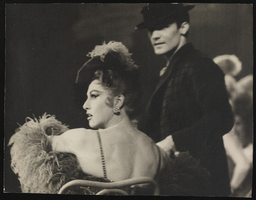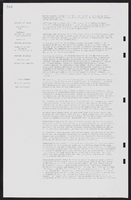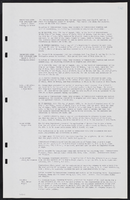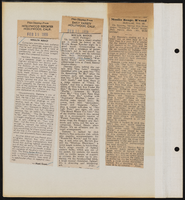Search the Special Collections and Archives Portal
Search Results

Set of photographs including a wrecked truck for Ray's father, Wilma Prudhummne, a horse jumping, Trena, and Loronza Calhumn
Date
Archival Collection
Description
Photographer's notations: Wrecked truck for Ray's father, Wilma Prudhummne [?] (at Moulin Rouge), Horse jumping (at Highland), Trena (sleeping), Loronza Calhumn (family).
Image
Elizebeth Dewey Russell oral history interview
Identifier
Abstract
Oral history interview with Elizebeth Dewey Russell conducted by Claytee D. White on March 23, 2024 for the African Americans in Las Vegas: a Collaborative Oral History Project. In this interview, Russell talks about her mother, Ruth Bradshaw Dewey, a white woman, who taught at the Westside School (1949-1955), saw Josephine Baker at the El Rancho in 1952, attended the opening night of the Moulin Rouge in 1955, and served as the secretary of the Las Vegas branch of the NAACP for several years. Russell describes living with her mother in the Mayfair deveopment just south of 17th Street at Charleston and graduating from Las Vegas High School. She recalls spending summers with her father, John Bradshaw, in Caliente, Nevada, where he worked as a mechanic for the Union Pacific Railroad.
Archival Collection
Katherine Duncan and Sarann Knight Preddy
Identifier
Abstract
Oral history interview with Katherine Duncan and Sarann Knight Preddy conducted by Claytee D. White on November 11, 2004 for the Boyer Early Las Vegas Oral History Project. In this interview Katherine Duncan and Sarann Preddy speak about creating a black cultural/historical tour of Las Vegas, Nevada. Preddy also discusses buying the Moulin Rouge Hotel and Casino to preserve its history. Both women then talk about racism, segregation, and the involvement of African Americans in the history of Las Vegas.
Archival Collection

Photograph of Ffolliott Charlton, Hollywood (Calif.), 1950s.
Date
Archival Collection
Description
Image
Thelma Turner oral history interview
Identifier
Abstract
Oral history interview with Thelma Turner conducted by Claytee D. White on October 21, 2004 for the African Americans in Las Vegas: a Collaborative Oral History Project. In this interview, Turner discusses her family background and moving to Las Vegas, Nevada in 1947. She describes the city at the time and recalls her educational experiences while attending the Fifth Street School and Las Vegas High School. Turner then talks about her involvement as a teacher for Sunday church school and her employment at the Moulin Rouge Hotel-Casino as a change girl and waitress. Later, Turner discusses the Helldorado Parade, racial integration, and being the first African American family to move to North Las Vegas in 1966. Lastly, Turner describes housing and what the community was like in the Westside.
Archival Collection




